It seems practical to assume that Phase I had at least two stage doors, one left and one right, which follow the angled frons scenae. Plays known to have been written for or staged at the post-1591/2 Rose call for two stage doors (5.9.2).177 The frons also suggests the possibility of a third, central opening/alcove or ‘discovery space,’ possibly with a set of doors, 178 and again plays known to have been written for or staged at the post-1592 Rose call for a central opening (see 5.9.3 and 5.9.4). Furthermore, around eight-hundred stage directions in plays from the early modern period call for use of such a central space, according to Alan Dessen and Leslie Thomson’s A Dictionary of Stage Directions in English Drama, 1580–1642, which suggest its inclusion was a general feature of London’s playhouses.179 Unless these were innovations only added when Henslowe altered his playhouse, it seems likely to have also featured at the early Rose.180
The sketch of the Swan (fig. 26 [4.4.1]) shows two arched doors onto the stage, similar to the entrances onto the stage at Palladio’s Teatro Olimpico (fig. 61). Here, for ease the doors themselves have been modelled on those at the reconstructed Shakespeare’s Globe in London, and a central opening added.
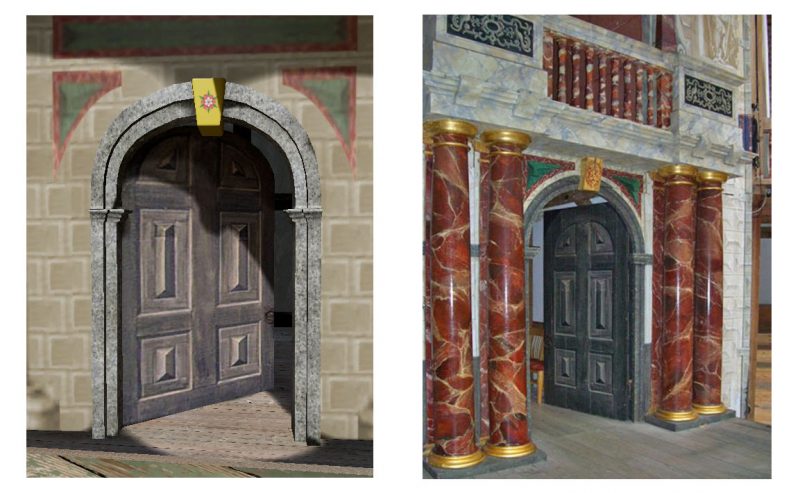
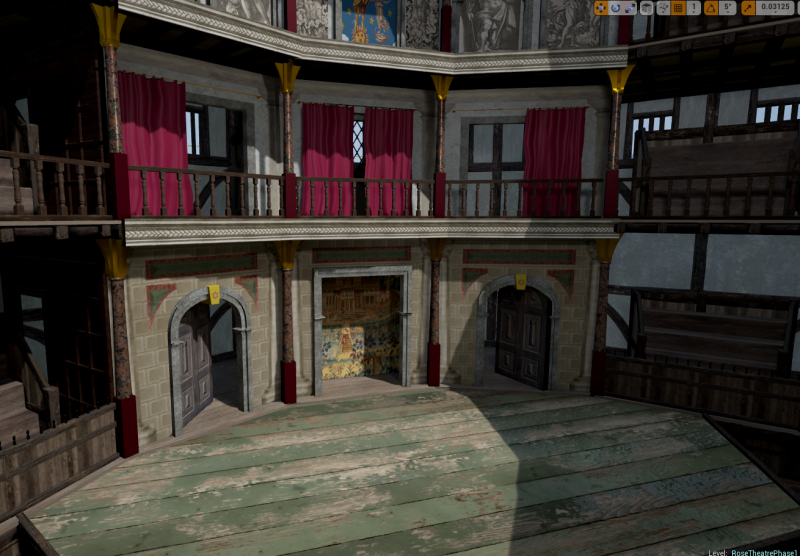
Gurr and Mariko Ichikawa conclude that the central opening was used in plays to represent a recessed space, such as a cave; for hiding behind the hangings; siege scenes, where defenders appear ‘above’ on the walls with the besiegers standing below before the central opening, representing ‘gates’; for masques and dumb shows; used by special figures, such as supernatural beings and Choruses; for formal and ceremonial processions; and used symbolically to emphasise harmonious general exits.181 Gurr argues that sightlines for such a discovery space at the Rose would have been aided by the angled frons, and ‘might have allowed the viewers in the flanking boxes to see something of what was displayed behind the hangings.’182
Gurr argues that if Doctor Faustus (first published 1604) was ever staged at the early Rose, ‘his study, probably in both pre- and post-1592 versions of its staging, must have been in the discovery-space.’ He also suggests ‘that there was a discovery-space on one of the early stages, possibly the Rose, we know from The Spanish Tragedy and that odd stage direction “Enter Hieronimo, he knocks up the curtaine.” The curtain must have been located in front of the discovery-space because of what it concealed, and was probably its hangings, whatever the precise action of knocking the curtain up entailed. Hieronymo has already referred to a pre-Polonian arras when he says “I will have there behind a curtaine”.’183 Lastly, Gurr argues that ‘some kind of hangings were certainly available for The Battle of Alcazar, possibly on the Rose’s early stage, since in Act 1 the dumb show has murderers who “draw the curtains and smoother the yong princes in the bed”.’184 According to Dessen and Thomson, no fewer than 115 stage directions in surviving play texts from 1580–1642 call for use of ‘arras,’ ‘curtain,’ ‘hangings’ or ‘traverses.’185
In his English–Italian dictionary, Florio defines scena as ‘a stage in a theatre or play-house, whereon they play, a skaffold, a pavilion, or fore part of a theatre where players make them readie, being trimmed with hangings, out of which they enter upon the stage … also a place where one doth show or set forth himself to the world,’186 and Thomas defines the word ‘cortina’ in his Dictionarium (1587) as ‘the couered place in a stage, whence the players come out’.187 In his transcript of Henslowe’s inventories, now lost, Edward Malone records ‘The Enventary of all the properties for my Lord Admiralles men, the 10 of marche 1598,’ which includes ‘the sittie of Rome’ and ‘Tasso’s picture’ and seems likely to record woven or painted hangings (also referred to interchangeably as arras, tapestry, curtain, traverse).188 Gurr and Ichikawa determine that ‘The central opening was concealed behind a hanging or elaborate cloth woven in panels with pictures of scenes from classical myths. This cloth of ‘arras’ which concealed the central opening … was a heavy tapestry weave’ and used for special entrances and ‘discoveries.’189 Bruce R. Smith, in his review of all early modern plays involving use of the curtains, extends these activities to the player for ‘hiding, discovering, sexual pleasuring, sleeping, dying, reading, writing, dreaming, eating, moving from one place to another’; for the spectator, the curtains were ‘sites of expectation, enticements for looking, invitations to the play of fantasy, preparations for the focussed seeing and listening that defined dramatic scenes’.190
The stage, Phase I © De Montfort University, Leicester, UK. To view the image using Google Cardboard, click here.
Ronayne points out that such hangings would have been familiar to playgoers as the default decoration of citizen’s and prosperous yeomen’s houses in Tudor times. The point of these cloths was their iconography and stories, not their intrinsic material quality, and they were the economy versions of tapestries, which would have been too costly to use upon the stage.191 Early modern playhouse cloths were typically decorated with biblical scenes, mythological or allegorical scenes, as the several allusions to them in playtexts confirm.192 William Shakespeare’s Henry IV, Part I, talks of ‘Lazarus in the painted Cloth’ (IV.ii.25);193 Francis Beaumont’s The Knight of the Burning Pestle (Q1 1613 [1607]) has the Citizen (George) and his Wife (Nell) discuss the depiction of the rape of Lucrece ‘painted vpon the [stage] cloth’;194 John Day’s Law Tricks (1608 [c. 1604]) features discussion of the hangings that are decorated with ‘the Poeticall fiction of Venus kissing Adonis’;195 and Thomas Middleton, A Mad World, My Masters (Q1 1608 [1605]) features curtains ‘with the story of the Prodigall child in silke and golde’.196
A vignette by John Payne (engraver) of a stage on the title page of Alabaster’s Roxana Tragaedia (1632) features plain curtains with a central opening behind the actors in the foreground,197 and a similar stage vignette by Thomas Rawlins (engraver) on the title page of Richards’ Messallina (1640) portrays a figure of Cupid on one curtain shooting an arrow towards a figure in front of a landscape on the other, again with a central opening.198 The curtains or arras at the back of the stage depicted on the frontispiece of The Wits, Or, Sport upon Sport, Part I (1662) feature a pattern of swirls.199 Whilst all but the first of these sources listed pertain to indoor theatres, it is likely the open-air playhouses employed decorated hangings.
Where the cloth or curtains were plain (undecorated), Smith suggests that green was the colour of choice in Tudor playhouses, 200 resonating psychologically as well as geographically with semi-rural surroundings of London’s playhouses, those open green pleasure seeking spaces in which, John Stow observes, ‘the youthes of this Citie, have in the field exercised themselves, in leaping, dauncing, shooting, wrestling, casting of the stone or ball &c.’201 Ichikawa draws attention to the customary use of black curtains for signalling the performances of a tragedy—’or perhaps tapestries or cloths depicting tragic histories,’ as Smith suggests202—the effect adding to the dark mood of the play (their absence likewise signalling a comedy was to be played): for example, in the induction to A Warning for Fair Women (1599 [1599]) the personification of History tells Comedy, ‘The stage is hung with blacke: and I perceiue / The Auditors preparde for Tragedie ‘203 Black was associated with mourning, sorrow and evil but also constancy and obstinacy: ‘blacke and all other colours signifie either good or evill, as they are rightly applied,’ and produces in the spectator ‘tardity, musing, melancholie, &c,’ whereas green ‘yeelde[s] a pleasurable sweetnesse.’204
Ichikawa suggests that the curtains and hangings were most likely attached to poles using curtain rings, which evidence suggests were common enough, and hung up on hooks, which would facilitate them being easily taken up and down (sometimes between acts as some plays suggest).205 She concludes that for the most part such hangings were placed in front of the central discovery space, to facilitate reveals for example, rather than in front of the flanking stage doors right or left, but concedes that curtains may have been used behind the stage doors to provide privacy and restrict views into the tiring house.206 However, Fitspatrick believes that such a cumbersome means of providing privacy was unnecessary and points to what he believes is clear evidence that some playwrights expected there to be curtains used as hangings in front of the flanking doors in two plays, which would have both provided privacy and allowed for entrances and exits through a split in the hanging: he argues that in Edward Sharpham’s Cupid’s Whirligig (1607 [1607]), Wages has Lady and Nan hide behind some hangings to await the arrival of the Knight, who when he enters hides himself behind what must be a second set of hangings as the Lady appears from the other; and in Sir William Davenant’s The Wits (1636 [1634]), one of the stage doors provided both a closed door for Lucy to knock at and to enter through and, a little later, an open door for Young Pallentine to gesture through the split in the hangings.207 Tim Fitzpatrick argues that both examples suggest there must have been ‘two symmetrical sets of hangings available—not one (or just one) central set—and that these two sets of hangings were in open doorways.‘208 Both of these plays were performed in indoor private theatres, and neither provide firm evidence for curtains in front of the flanking doors during either phase of the Rose.
For the purpose of modelling the Phase I Rose playhouse, an image of a castle was taken from a tapestry (fig. 57) and is placed in front of the central opening. It befits a backdrop to the many ‘history’ plays that featured at the Rose playhouse.
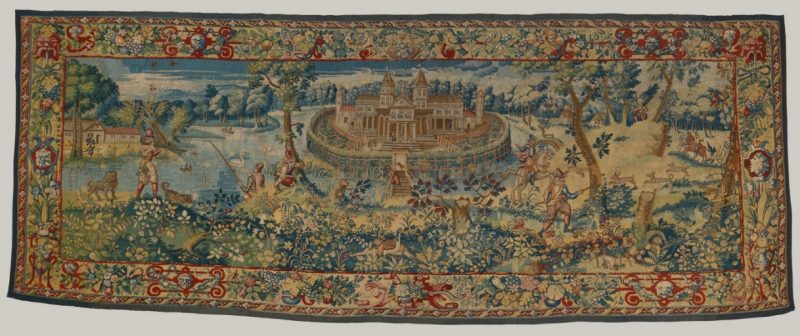
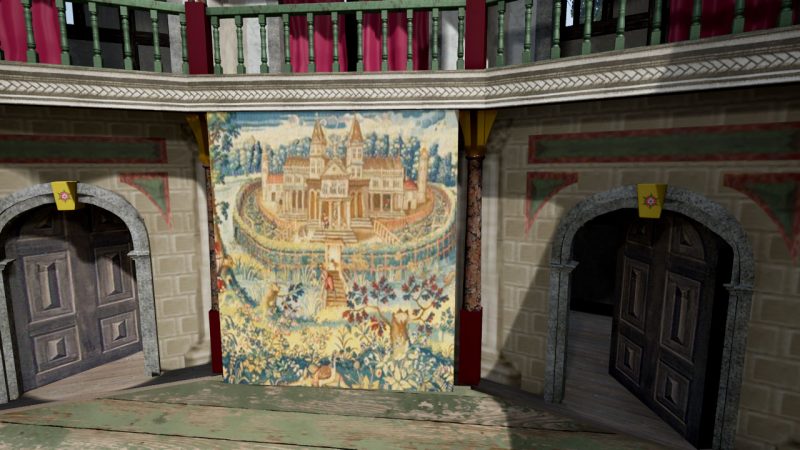
Whether the discovery space also had doors isn’t certain.209 Reference in post-1591/2 Rose plays to the central opening representing gates to the city might suggests doors were present, although here the hangings might be equally representative. The ability to close off the tiring house entirely with doors may have at least offered sensible protection to the items stored inside.
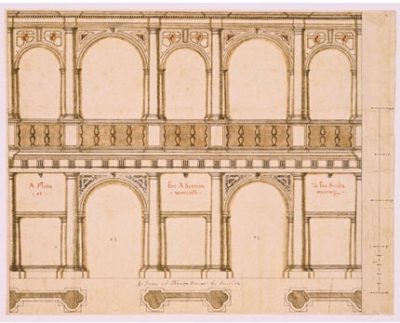
We have no real notion of how the tiring house frons scenae would have been decorated at the Rose playhouse, although it is possible to draw inference form other sources, but that it would have been decorated is certain.
For the back wall of the frons scenae, the model utilises some of the design by Robert Smythson (c. 1535–1614) for a double height screen for Worksop Manor, in Bassetlaw, Nottinghamshire (fig. 58).
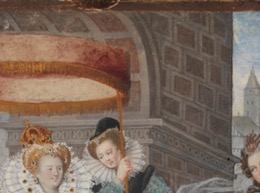
Elizabeth I and the Three Goddesses
(c. 1590) © National Portrait Gallery,
London
It has been painted to resemble smooth ashlar block work, shadowed in dark and light shades along the lines of the painting by Hans Ebsworth, Elizabeth and the Three Goddesses (1575) and Isaac Oliver’s depiction of the same scene (c. 1590) (fig. 59), which shows the queen stepping out through an arch painted with fictive stonework.
The central face of each stone is picked out in a darker tone, a pattern illustrated by Nicola Sabbatini in his Pratica di fabricar scene e machine ne’ teatri [Manual for Constructing Theatrical Scenes and Machines] (1638) (fig. 60).
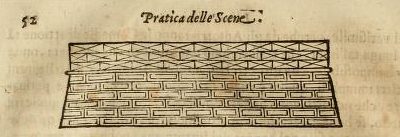
Pratica di Fabricar Scene e Machine ne’ Teatri (1638)211
Throughout the model, the uprights supporting the galleries have been rounded and painted. The contract for Henslowe’s later Hope playhouse stipulates ‘Turned Cullumes vppon and over the stage’ (not referring to those holding up the Heavens because at the Hope there were none).
Behind the wooden rounded pillars either side of the two doors and the central opening have been painted square pillars, with bases/plinths, resembling those behind the round columns in the frons scenae of Palladio’s Teatro Olimpico (Vicenza, 1580–85) (fig. 61) and Stephen Harrison’s triumphal arch, proposed in 1603 for the entry of James I to London (fig. 62), contemporary with the Rose.
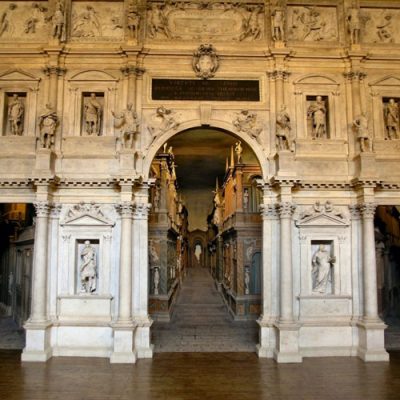
sixteenth-century Teatro Olimpico
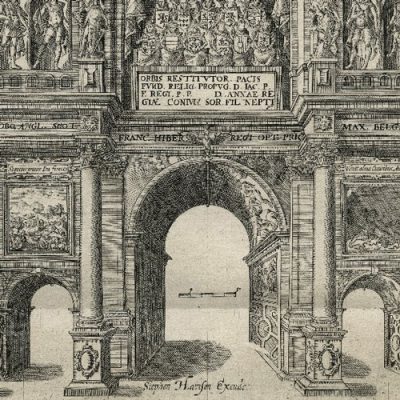
Separating each level of the frons scenae is a design for Roman fretwork by Hans Vredeman de Vries (fig. 63), painted to look like carved stone, also contemporary with the Rose.
Separating each level of the frons scenae is a design for Roman fretwork by Hans Vredeman de Vries (fig. 83), painted to look like carved stone, also contemporary with the Rose.

[177] For a discussion of the use of the two flanking doors in staging plays, see Gurr and Ichikawa, Staging in Shakespeare’s Theatres, 96–104.
[178] For discussion of the evidence for the existence and use of central opening in Tudor playhouses, see Gurr and Ichikawa, Staging in Shakespeare’s Theatres, 104–13. For a challenge to the necessity of the discovery space, see Tim Fitzpatrick, Playwrights, Space, and Place in Early Modern Performance: Shakespeare and Company (Farnham: Ashgate, 2011), who argues that the absence of a central opening in De Witt’s sketch of the Swan Playhouse (see fig. 26 [4.4.1]) suggests that suggests that the large double doors positioned stage left or right, which may have been typical of other public playhouses, were the location of discoveries and reveals. It is possible that the absence of the central discovery space in the sketch of the Swan may be because during De Witt’s visit the hangings in front of it were not used for entrances and exits and that what he recorded in his sketch was what he assumed to be a solid wall behind them rather than the detail of the decoration in front.
[179] Alan Dessen and Leslie Thomson, A Dictionary of Stage Directions in English Drama, 1580–1642 (Cambridge: Cambridge University Press, 2001).
[180] Gurr thinks that ‘in both pre- and post-1592 plays it seems that at least two stage doors were expected, and possibly a third, though as usual that likelihood is confused by the question of the discovery space and its hangings being used for entries … There was quite possibly a discovery space at both Roses, though the full range of the things it was used for is not known for certain’ (Gurr, ‘The Rose repertory,’ 120, 124).
[181] For a discussion of the use of the central opening in staging plays, see Gurr and Ichikawa, Staging in Shakespeare’s Theatres, 104–13.
[182] Gurr, ‘The Bare Island,’ 32.
[183] Gurr ‘The Rose repertory,’ 124–25, citing Kyd, The Spanish Tragedie, Sig . K1v, K2v.
[184] Ibid, 124–25; citing George Peele (?), The Battell of Alcazar , fought in Barbarie, betweene Sebastian king of Portugall, and Abdelmelec king of Marocco (London: Edward Allde, 1594), Sig. A2v (STC 2nd 19531). In the play, the character of Abdelmelec is referred to as Muly Molocco, which has led to it being linked to ‘Muly Molocco’ recorded by Henslowe as being performed by Strange’s Men in 1592-93 (Foakes, Henslowe’s Diary, 16-19). Henslowe’s inventory of costumes in March 1598 includes ‘Fierdrackes sewtes for Dobe’, which, Foakes suggests (317 n.; see also Chambers, The Elizabethan Stage, II, 175 and n), may link to a player, ‘Dab’, who is assigned the roles of Muly Mahamet’s young brothers, a ghost, Ruben’s young son, and an attendant in the dramatic ‘plot’ for the play, which also survives. (Such ‘plots’ were used backstage by playing companies and listed the scenes in the play, the players in each and their character, and functioned as a reminder to the players of when they would be needed on stage.)
[185] Dessen and Thomson, Dictionary of Stage Directions, 12, 62–63, 110, 235.
[186] John Florio, A World of Words (London, 1598), 351.
[187] Thomas Thomas, Dictionarium Linguae Latinae et Anglicanae (London: Richard Boyle, 1587), Sig. P2v; cited in Tiffany Stern, ‘Behind the Arras: The Prompter’s Place in the Shakespearean Theatre,’ Theatre Notebook 55.3 (2001), 112.
[188] Edward Malone, Historical Account of the English Stage, vol. III (London: R. C. and J. Rivington, 1800), 312.
[189] Gurr and Ichikawa, Staging in Shakespeare’s Theatres, 6–7.
[190] Bruce R. Smith, The Key of Green: Passion and Perception in Renaissance Culture (Chicago: University of Chicago Press, 2009), 242.
[191] Ronayne, ‘Totus Mundus Agit Histrionem,’ 136.
[192] See Keenan and Davidson, ‘The Iconography of the Globe,’ 152–54, and Mariko Ichikawa, ‘“What Story is that Painted Vpon the Cloth?”: Some Descriptions of Hangings and their Use on the Early Modern Stage,’ Theatre Notebook 70 (2016), 2–31.
[193] William Shakespeare, Shakespeares Comedies, Histories, and Tragedies, being a Reproduction in Facsimile of the First Folio Edition 1623 from the Chatsworth copy in the possession of the Duke of Devonshire, K.G. with an Introduction and Census of Copies by Sidney Lee (Oxford: At the Clarendon Press, 1902), 387.
[194] Francis Beaumont, The Knight of the Burning Pestle (London: Walter Burre, 1613), Sig. E4r (STC 2nd 1674).
[195] John Day, Law Tricks , or, Who Woul’d have Thought it? (London: Richard More, 1608), Sig. D4v-E1r (STC 2nd 6416).
[196] Thomas Middleton, A Mad World, My Masters (London: Walter Burre, 1608), Sig. C1v (STC 2nd 17888).
[197] William Alabaster, Roxana Tragaedia (London: William Jones, 1632), STC 2nd 250.
[198] Nathanael Richards, The Tragedy of Messallina, the Roman Emperesse (London: Daniel Frere, 1640), STC 2nd 21011.
[199] Francis Kirkman (?), The Wits, or Sport Upon Sport, Part I (London: Henry Marsh, 1662), Wing W3128. John H. Astington suggests that these pictures are unlikely to have any independent authority as the depiction of an actual theatre (Astington, ‘The Origins of the Roxana and Messalina Illustrations,’ 149–69; and J. H. Astington, ‘The Wits Illustration, 1662,’ Theatre Notebook 47.3 (1993): 122–40), although Bruce R. Smith argues there may be some credibility to the details in Rawlins’ frontispiece, which may perhaps have been inspired by John Payne’s frontispiece (Smith, The Key of Green, 225).
[200] Smith, The Key of Green, 228.
[201] John Stow, The Survey of London: reprinted from the text of 1603, ed. C. L. Kingsford (Cambridge: Cambridge University Press, 2015), Vol. I, 94; Smith, The Key of Green, 213.
[202] Smith, The Key of Green, 219.
[203] A Warning for Fair Women (London: William Aspley, 1599), Sig. A3r (STC 2nd 25089). For a discussion of the evidence of the use of black curtains in the early modern theatre, see Mariko Ichikawa, ‘“The stage is hung with blacke”: On the Use of Black Curtains for Tragedies in the Early Modern Period,’ Theatre Notebook 68.3 (2014), 153–88.
[204] Paolo Lomazzo, Tratatto dell’ Arte de la Pittura (English translation, 1598), Sig. KK2v–3v, cited in Smith, The Key of Green, 229.
[205] Ichikawa, ‘The stage is hung with blacke,’ 167–68.
[206] Ibid, 168–72; Mariko Ichikawa, ‘Were the doors open or closed? The use of the doors in Shakespeare’s Theatre,’ Theatre Notebook 60.1 (2006), 24.
[207] Edward Sharpham’s Cupid’s Whirligig (London: E. Allde, 1607), Sig. G4v and H1r (STC 2nd 22380); William Davenant, The Wits (London: Richard Meighen, 1636), Sig. C3r and C4v (STC 2nd 6309).
[208] See Fitzpatrick, Playwright, Space and Place in Early Modern Performance, 54-56.
[209] For discussion of doors in the central discovery space and their use, see Ichikawa, ‘Were the doors open or closed?’.
[210] ‘Design for a screen for Worksop Manor’ (RIBA12946, RIBA Library Collection, SC231/I/26).
[211] Nicola Sabbatini, Pratica di Fabricar Scene e Machine ne’ Teatri (Ravenna: P. de’ Paolo e G. B. Giovannelli, 1638), Bk I, 52.
[212] Stephen Harrison, The Arch’s of Triumph, Erected in Honor of the High and Mighty Prince James (London: John Sudbury and George Humble, c. 1613), Plate 4 (STC 2nd 12863a).
[213] Bowsher, The Rose Theatre, 41.
